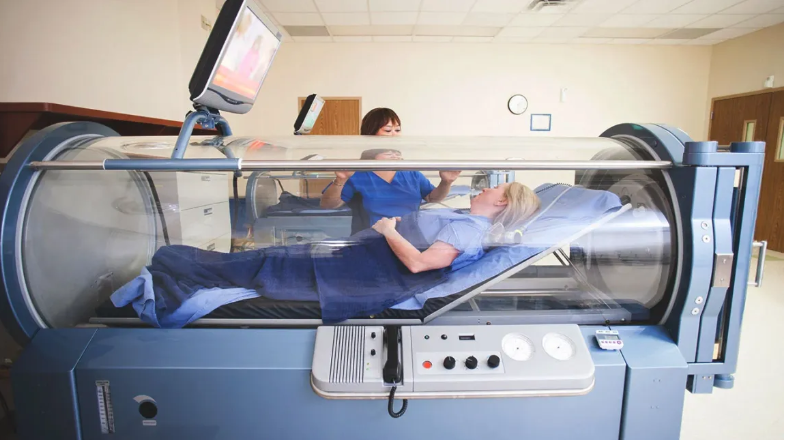Medicare hyperbaric oxygen therapy is a high-tech healing tune-up that surrounds the patient with pure, pressurised oxygen. Instead of regular air, the dense gas bath encourages cells to absorb far more oxygen than usual, speeding up the body’s natural repair jobs. In Australia, word of these turbocharged benefits is spreading, and more clinics are fitting out shiny hyperbaric chambers, from gym basements to seaside hospitals.
Because the therapy costs stack up quickly, Gentle Readers have a worthy question: is a Medicare rebate waiting at the end of the tunnel? The short answer is yes, but only if a doctor can tick one of the limited boxes the scheme allows. Conditions like deep-sea diving injuries, slow-healing diabetic wounds, or radiation damage are listed, while many trendy uses, though interesting, sit outside the rebate pool.
Sorting through the clinical rules, recommended settings and the full roster of eligible conditions helps patients see when the therapy’s price tag drops and when they are stuck paying the full bill.
How Hyperbaric Oxygen Therapy Works
In hyperbaric oxygen therapy a person steps inside a sturdy glass chamber, and the staff gradually pumps in air as though the patient had dived several metres below sea level. Inside the capsule the patient inhales pure oxygen instead of the usual room mix. Because of the added pressure, far more oxygen is able to dissolve in the blood and reach healing tissues. Then pale skin grows rosy, slow-moving fluid collects under swollen dermis and injured bones begin drinking desperate molecules like parched earth.
Doctors often call on the extra oxygen for stubborn wounds, deep infections and any injury or illness caused by low-enough oxygen. The treatment speeds up cell repair, calms swelling and gives the immune system a helpful nudge.
Several clinics around Australia now run the service, and even though the setup looks high-tech, the underlying idea has been around for more than a hundred years. Research backs up the benefits, yet anyone thinking about the dives should first check whether out-of-pocket costs line up with Medicare’s approval.
Medicare Coverage for Hyperbaric Oxygen Therapy
Medicare will pay for hyperbaric oxygen therapy, but only if the patient has one of the approved medical problems. Those problems must be listed in the official guidelines that doctors and researchers agree on.
The main issues that qualify are diabetic foot wounds, long-lasting bone infections, tissue infections where oxygen is blocked, at-risk skin grafts, diving-related decompression sickness, and heavy carbon monoxide poisoning. A few less-common cases can also be covered if a specialist asks and the hospital keeps close watch.
To get coverage, a patient usually needs a doctor referral that spells out why the treatment is needed and shows that other options failed. The sessions must happen at a Medicare-certified hospital or hyperbaric centre with the right licences.
Approval still rests on complete records, a clear care plan, and solid reasons signed by experts. Those steps help make sure the therapy is given fairly, safely, and only when it has a strong shot at helping the patient.
The Benefits of Hyperbaric Oxygen Therapy
Hyperbaric oxygen therapy is more than a fancy spa for cuts and scrapes. By flooding the bloodstream with pure oxygen, it speeds healing everywhere, making pain fade, energy rise, and movement easier. That’s a big deal for people with stubborn illnesses other treatments have left lonely and frustrated.
Take a person living with diabetes; a crusty foot sore that refuses to budge can slowly seal shut after just a few sessions. Someone emerging from radiation may watch pallid skin regain colour and strength because newly fed tissues grow faster. Even nasty, deep infections sometimes back off so quickly that the surgical knife stays put away.
These tiny miracles pile up, and quality of life lifts, especially for older Australians or anyone juggling several health puzzles. With wounds closing faster, there is less drumroll of antibiotics, shorter hospital road trips, and more time to do the things we all enjoy.
Accessing Medicare Hyperbaric Oxygen Therapy in Australia
If you think hyperbaric therapy could help you or someone you love, talk to a doctor you trust. Your family doctor or specialist will look at your health and decide if this treatment makes sense, then start the referral paperwork.
After that, the hospital or clinic runs its own check to see if you fit Medicare’s rules. If you do, Medicare usually pays most of the bill, especially if the therapy is done during a hospital stay or as part of a team plan at a public center.
Patients should also ask how many visits they will need because Medicare limits payment to a certain number based on the injury and what doctors expect. Sometimes a second review is required to keep coverage going past the first series of treatments.
Is Private Health Insurance Required?
Even though Medicare steps in for a range of serious conditions, patients who don’t meet those strict guidelines might still look at private insurance for hope. Many funds gladly cover hyperbaric oxygen therapy when it helps wounds heal after surgery, eases sports injuries, or puts a fresh finish on cosmetic procedures.
Because rules vary by fund, always chat with your doctor and your insurer before the first session. This way you’ll learn what the plan pays and spot any out-of-pocket costs you may still face.
Conclusion
When Medicare greenlights hyperbaric oxygen therapy, it gives millions battling chronic wounds, burns, and other oxygen-starved injuries a clear path forward. Approved sessions can speed healing, lower infection rates, and lift patients’ spirits, allowing them to return to their daily lives much sooner.
Knowing the exact Medicare criteria, gathering the right paperwork, and sticking to scheduled follow-ups unlock this powerful treatment. By teaming up with their physician and tapping into Australia’s well-organised public health system, patients can enjoy care that is both safe and methodical.
Whether you are caring for a stubborn diabetic sore, fighting off a bad infection, or bouncing back from radiation side effects, hyperbaric oxygen therapy could be the extra boost your body needs to heal and feel strong again.






